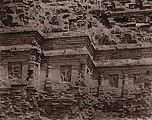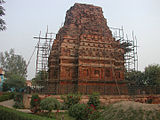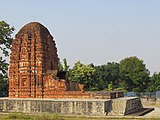Bhitargaon
Bhitargaon is a town in Kanpur district, Uttar Pradesh, India, known for its ancient Hindu temple.
Bhitargaon Temple
The Bhitargaon Temple is a terraced brick building fronted with a terracotta panel. Built in the 5th century during the Gupta Empire,[1][2][3][4][5][6][7][8] it is the oldest remaining brick/terracotta Hindu shrine with a roof and a high Shikhara, though its upper chamber did sustain some damage in the 18th century.
The temple is built on a square plan with double-recessed corners and faces east. There tall pyramidal spire over the garbhagriha. The walls are decorated with terracotta panels depicting aquatic monsters, Shiva and Vishnu etc. When Cunningham first visited the site, the remains of the porch and of the ardhamandapa were still visible, which later collapsed.
Gallery
-
Front view of the temple at Bhitargaon, Kanpur District
-
Rear view of the temple at Bhitargaon, Kanpur District
-
Close view of temple façade showing detail of mouldings and sculpture niches
-
Close view of temple façade showing detail of mouldings and sculpture niches, Bhitargaon
-
The oldest remaining Hindu shrine Brick Temple, Kanpur.
-
Sirpur Lakshman Temple
The construction material is bricks and terracotta. The brick size is 18"*9"*3" and the other salient features are following:
- The size of platform on which the temple is built is 36 feet*47 feet.
- The santum is 15 feet * 15 feet internally.
- The santum is double story.
- The wall thickness is 8 feet.
- The total height from ground to top is 68.25 feet.
- There is no window.
- The terracotta sculpture depicts both secular and religious theme such as deities like ganesha adi virah mahisasaurmardani and river goddess. Myths and stories representing abduction of Sita and the penance of nara and narayan.
- Shikara is a stepped pyramid and got damaged by thunder in 1894.
- The first story of sanctum felled in 1850.
- Vaulted arch is used here for the first time anywhere in India.[citation needed]
Other historic brick temples
- Po Nagar and Po Klong Garai
- Mahabodhi Temple
- id:Candi Bima Dieng Candi Bima
- Sambor Prei Kuk
- Sirpur (Chhattisgarh) Laksman temple
- Rajgir Maniyar Math, Vaibhar giri temples
- Bishnupur, Bankura
- [1] Kherahat temple[9]
- [2] Kalar, brick temple
See also
- Hindu temple architecture#Historical ChronologyHindu temple architecture- Historical Chronology
- Gwalior#Teli k.C4.81 Mandir Teli Ka Mandir, Gwalior
References
- ^ Schastok, Sara L., The Śāmalājī Sculptures and 6th Century Art in Western India. BRILL, 1985.
- ^ Jayewardene-Pillai, Shanti, Imperial Conversations: Indo-Britons and the Architecture of South India. Yoda Press, 2007.
- ^ Begler, Joseph David, Rear view of the temple at Bhitargaon, Kanpur District. British Library, 2009.
- ^ Brown, Percy, Indian Architecture (Buddhist and Hindu Periods). D B Taraporevala, Mumbai, 1959.
- ^ Harle, J. C., Gupta Sculpture. Munshiram Manoharlal, New Delhi, 1974. ISBN 8121506417.
- ^ Dalal, Roshen, The Religions of India: A Concise Guide to Nine Major Faiths. Penguin Books India, 2010.
- ^ Kramrisch, Stella and Raymond Burnier, The Hindu Temple, Volume 1. Motilal Banarsidass Publ., 1976.
- ^ de Laet, Sigfried J., History of Humanity: From the seventh to the sixteenth century. UNESCO, 1994.
- ^ A Brick Temple of the Ninth Century, Michael D. Willis, Artibus Asiae , Vol. 52, No. 1/2 (1992), pp. 25-46, Artibus Asiae Publishers
External links
- Bhitargaon
- Bhitargaon temple
- Heritage and Tourism, Kanpur City Development Plan
- Brick temples [3]






